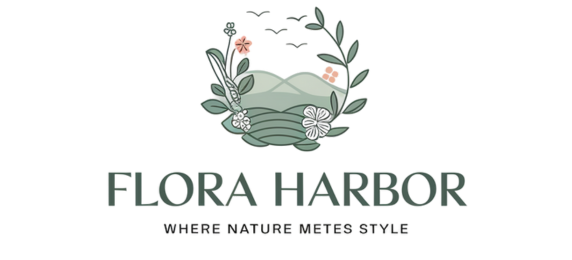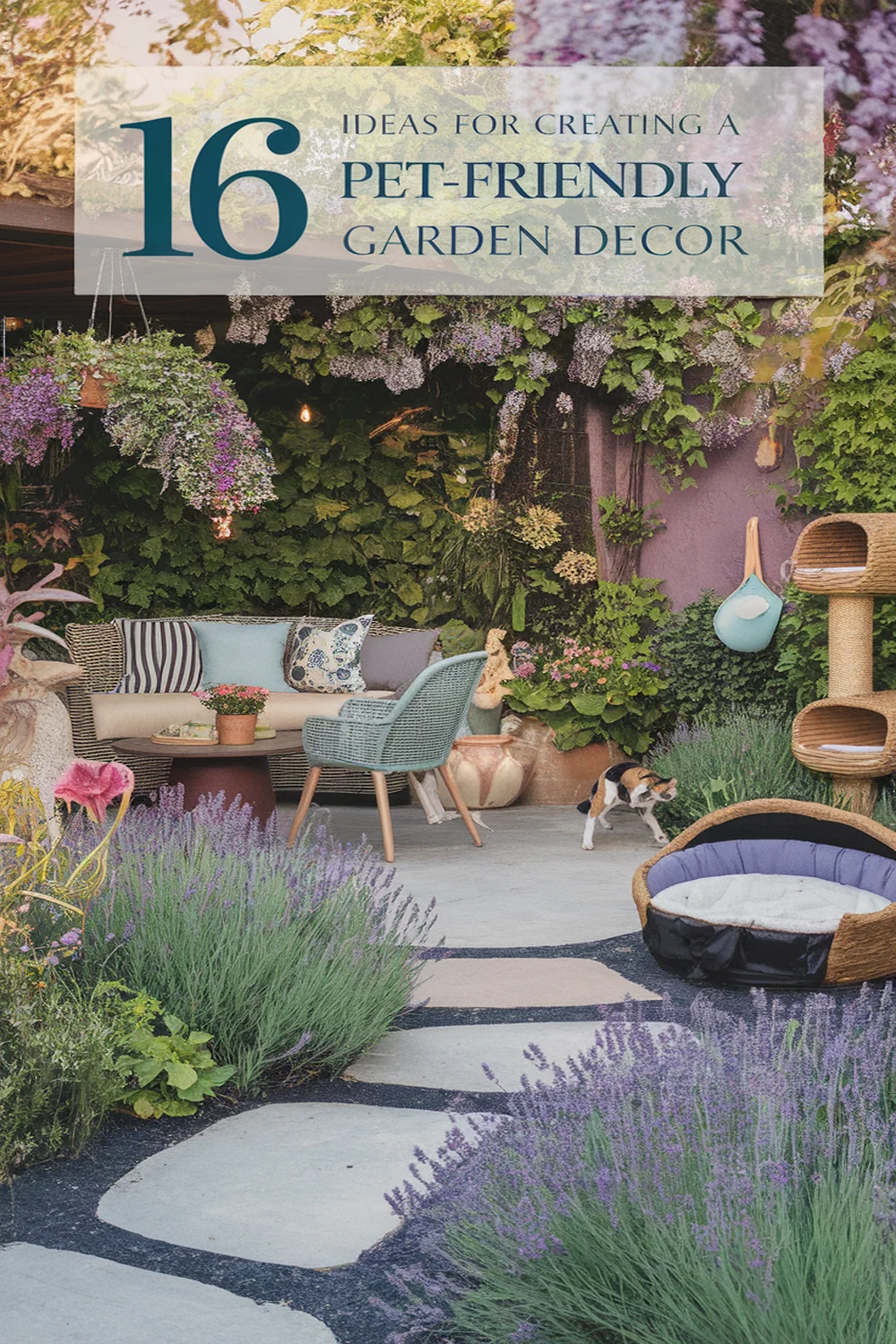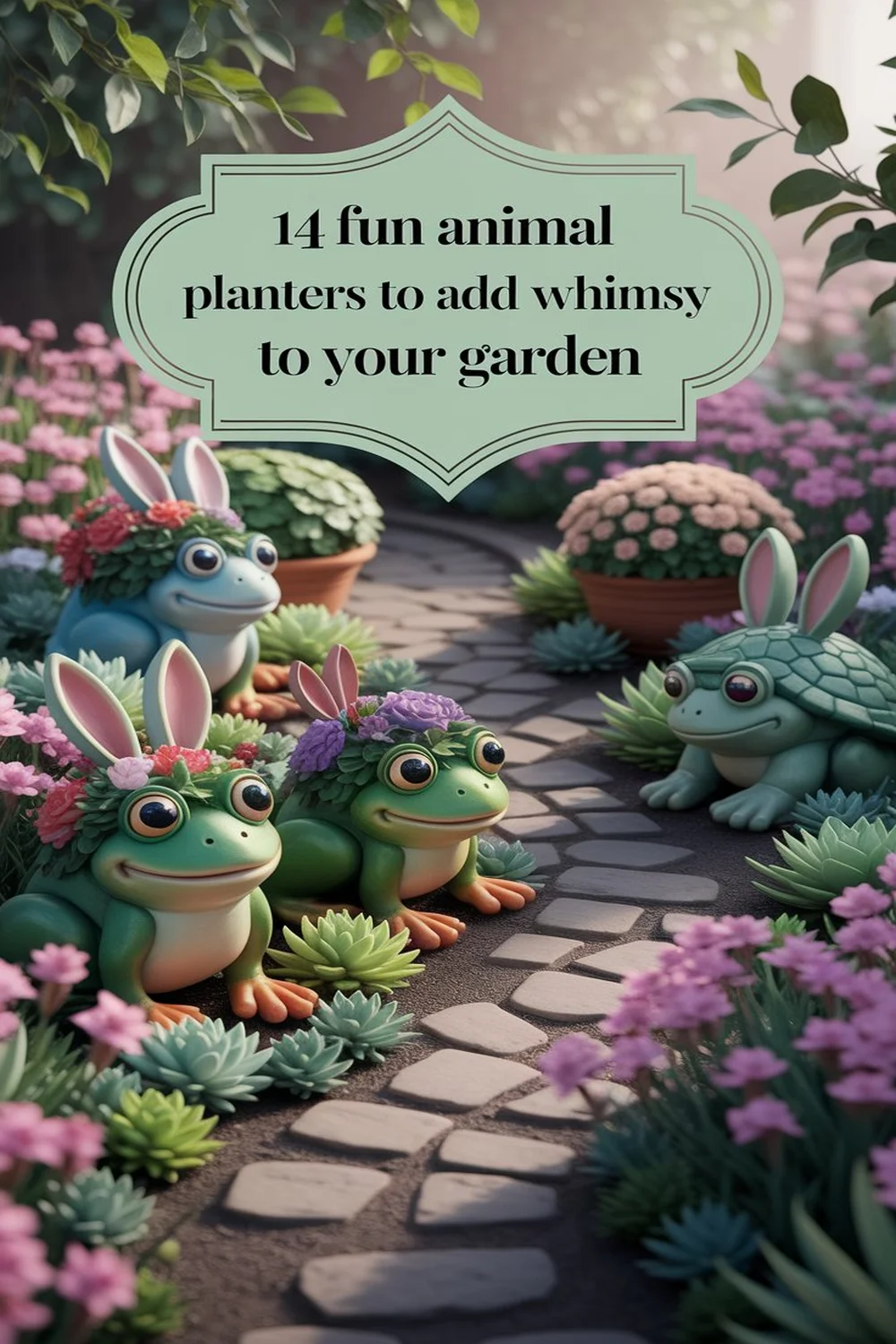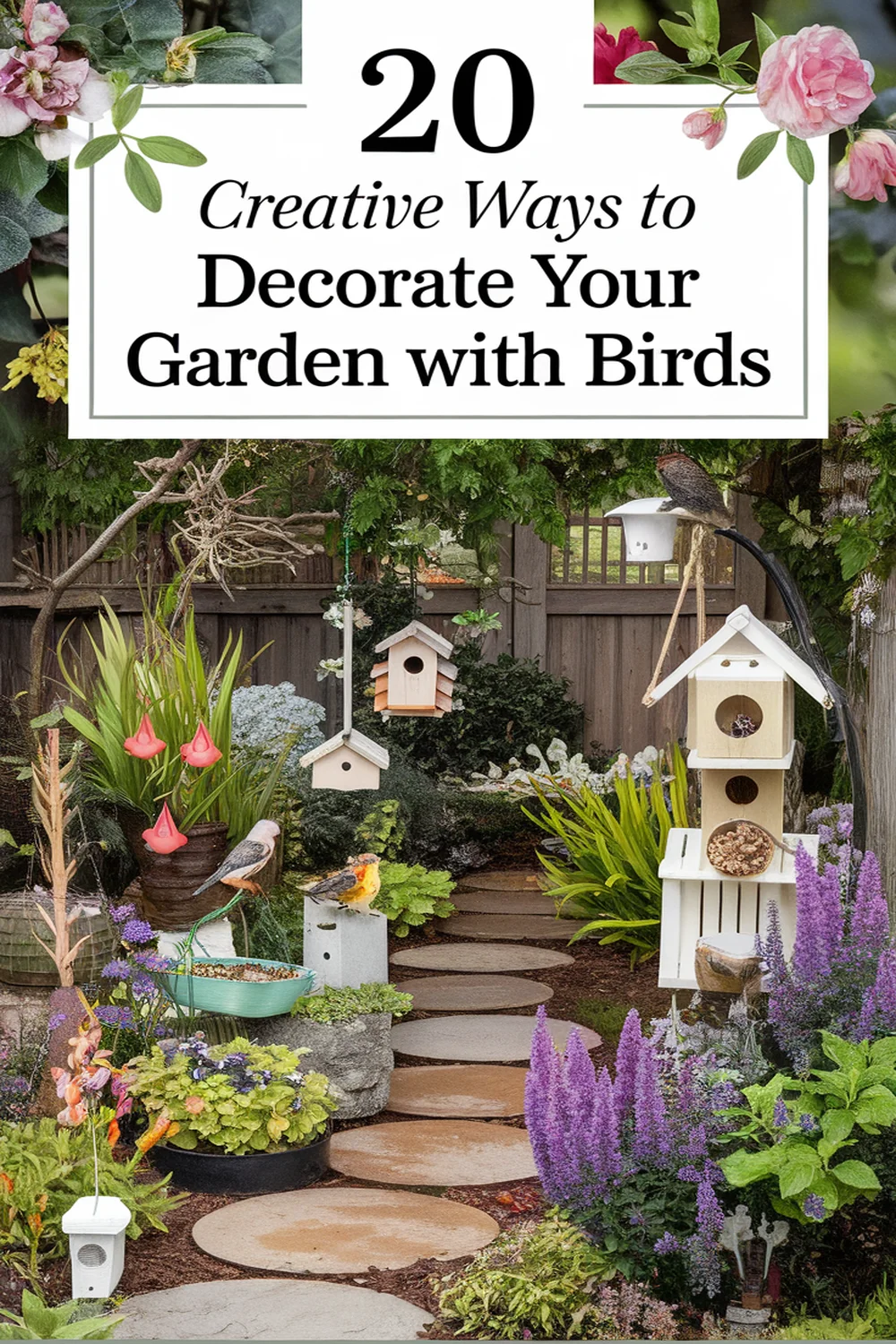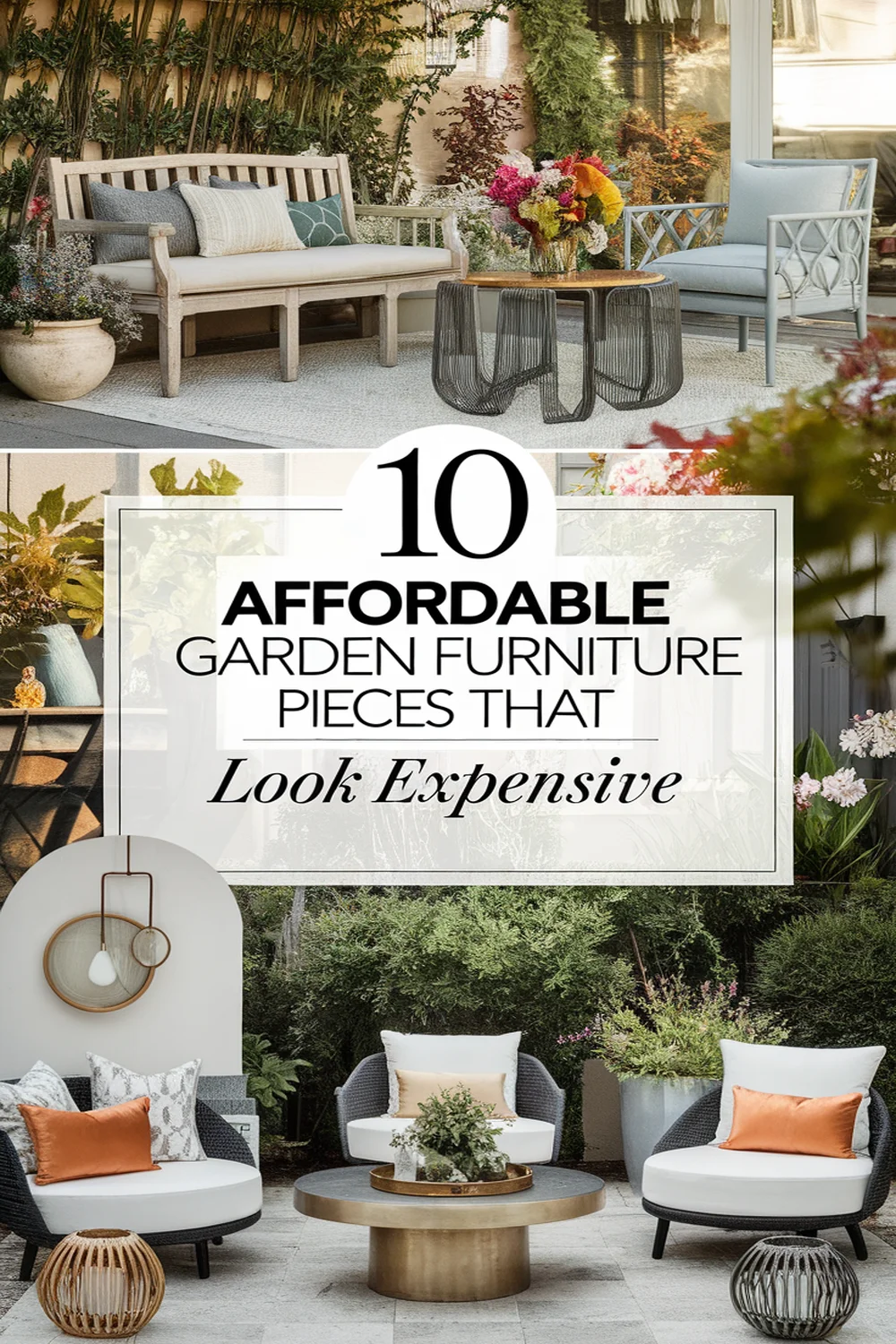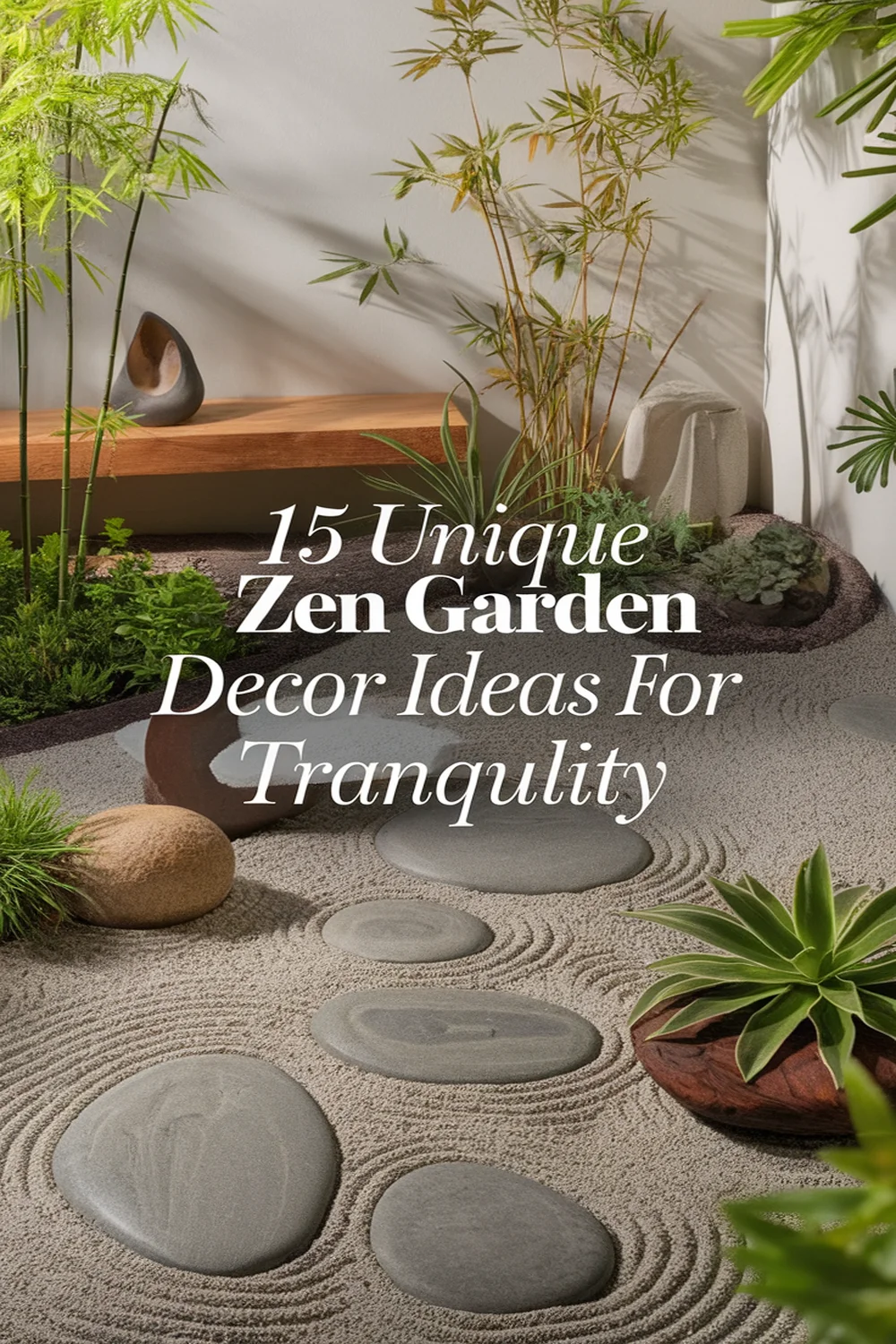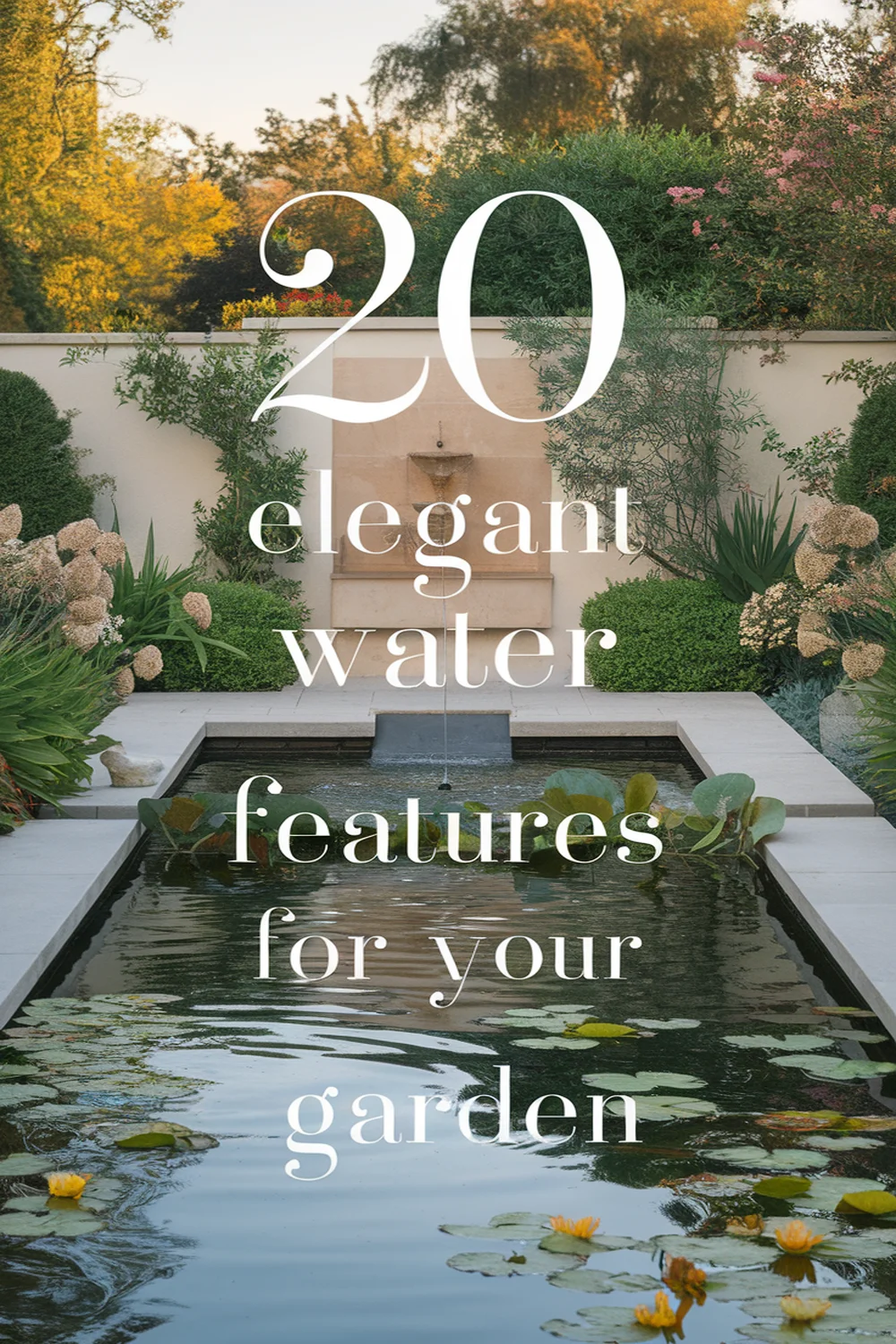This post may contain affiliate links. Please read our policy page.
To attract wildlife to your garden with decor, install bird feeders and use unique birdhouses for nesting. Create a butterfly garden with native plants for pollinators, and add a water feature for hydration. Hang colorful wind chimes to entice birds with sound, and incorporate solar-powered landscape lighting to highlight beauty at night. Design a Zen garden for tranquility and use repurposed art for charm. Keep exploring to discover even more creative ideas for your wildlife-friendly garden!
Install Bird Feeders

To attract a variety of birds to your wildlife garden, installing bird feeders is a key step. Choose feeders designed for specific bird species to entice them effectively. For example, sunflower seed feeders attract finches, while suet feeders appeal to woodpeckers. Place the feeders in sheltered spots near shrubs or trees to provide safety and easy perching. Make sure to keep them clean and refill them regularly; this creates a reliable food source that birds appreciate. You might also consider adding a mix of seeds to attract different species. Position your feeders at varying heights, creating a visually interesting landscape while catering to birds’ diverse feeding habits. By doing this, you’ll enhance the beauty of your garden while inviting vibrant wildlife.
Use Birdhouses in Unique Designs

Adding birdhouses in unique designs can further enhance your wildlife garden, creating inviting homes for a variety of bird species. Consider choosing birdhouses shaped like cottages, whimsical mushrooms, or even vintage teapots—these playful designs not only serve a purpose but also add character to your space. Make sure the materials are sturdy and weather-resistant to withstand the elements.
Position the birdhouses at different heights and in various locations to attract a diverse range of birds. Don’t forget to include natural elements, like twigs or leaves, for a touch of authenticity. Keep them clean and well-maintained to encourage nesting. A beautifully crafted birdhouse can be a real focal point, inviting both feathered friends and garden admirers alike.
Recommended Items
Get ready to welcome nature into your garden! Here are our recommended products and equipment to install—feel free to explore!
Products
Create a Butterfly Garden
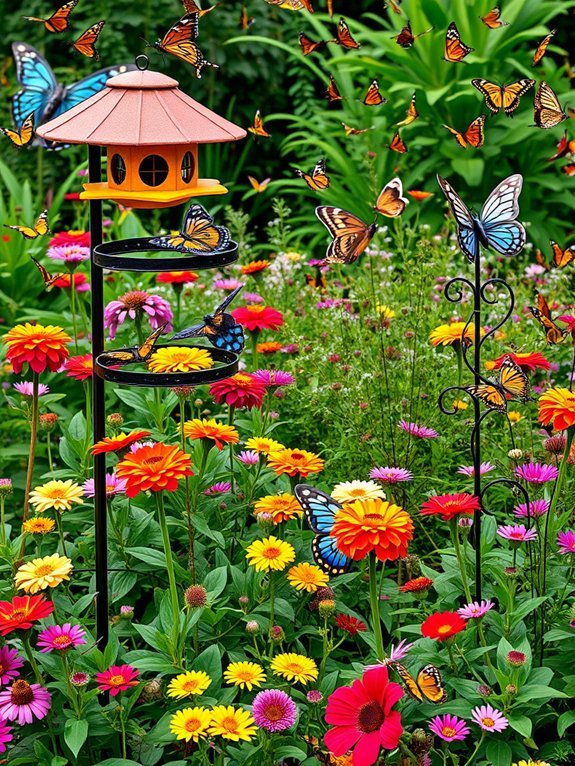
Creating a butterfly garden can transform your outdoor space into a vibrant oasis, attracting these delicate creatures with colorful blooms and essential habitats. Start by including a mix of nectar-rich flowers and host plants where butterflies can lay eggs. Opt for sunny spots and provide shelter with shrubs or small structures. Water sources like shallow dishes can keep them hydrated.
| Element | Purpose | Example Flowers |
|---|---|---|
| Nectar Plants | Food source for adults | Purple Coneflower |
| Host Plants | Habitat for caterpillars | Milkweed |
| Shelter | Protection from predators | Ornamental grasses |
| Water Source | Hydration | Shallow bird baths |
With these elements, you’ll create a flourishing environment for butterflies to thrive!
Incorporate Native Plants
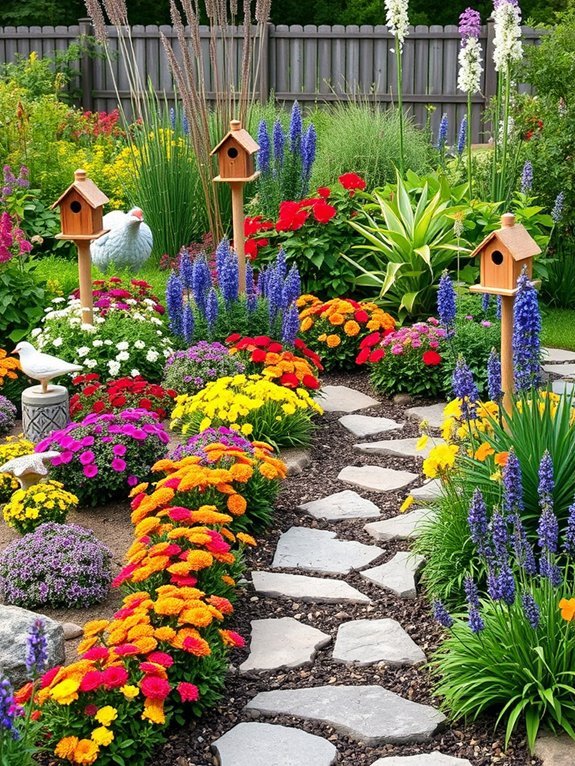
Incorporating native plants into your wildlife garden not only enhances its beauty but also supports local ecosystems. These plants have co-evolved with local wildlife, providing food and habitat for insects, birds, and small mammals. When you choose native species, you’re likely to see an increase in pollinators like bees and butterflies. Plus, they’re often more drought-resistant and require less maintenance compared to non-native varieties. To start, research which native plants thrive in your area and consider planting a variety to create a balanced ecosystem. Grouping plants in clusters will attract more wildlife by creating natural habitats. By focusing on native plants, you’ll be creating a garden that’s not only visually appealing but also a crucial refuge for local wildlife.
Add a Water Feature
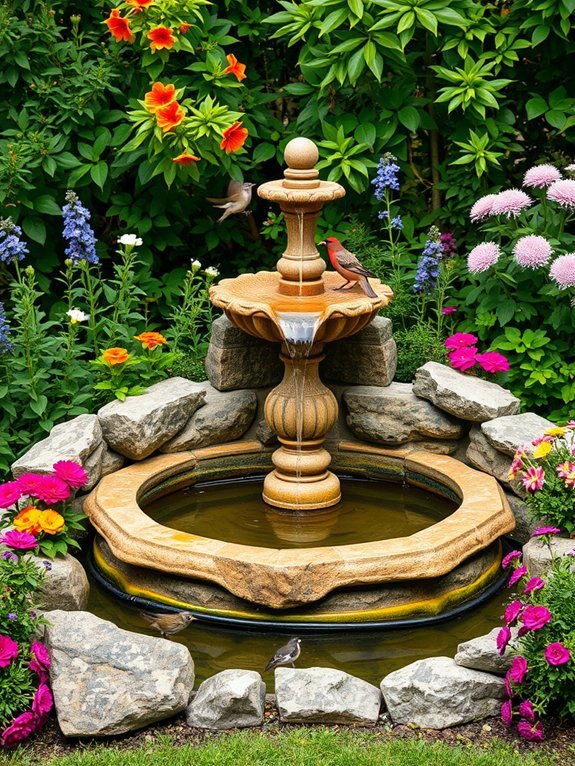
A water feature can dramatically enhance the appeal of your wildlife garden while also providing essential resources for local creatures. By adding a small pond, birdbath, or bubbling fountain, you create a habitat that attracts various wildlife. Birds will flock to bathe and drink, while frogs and insects will thrive in and around the water.
Choose a location that gets sunlight most of the day, as this helps keep the water fresh and promotes plant growth. It’s vital to include shallow areas for easy access and to plant native aquatic plants around the edges for shelter. Regular maintenance is essential, too, like cleaning out debris to maintain a healthy environment. With a water feature, you’ll invite a lively ecosystem right to your garden!
Use Decorative Stones and Pebbles
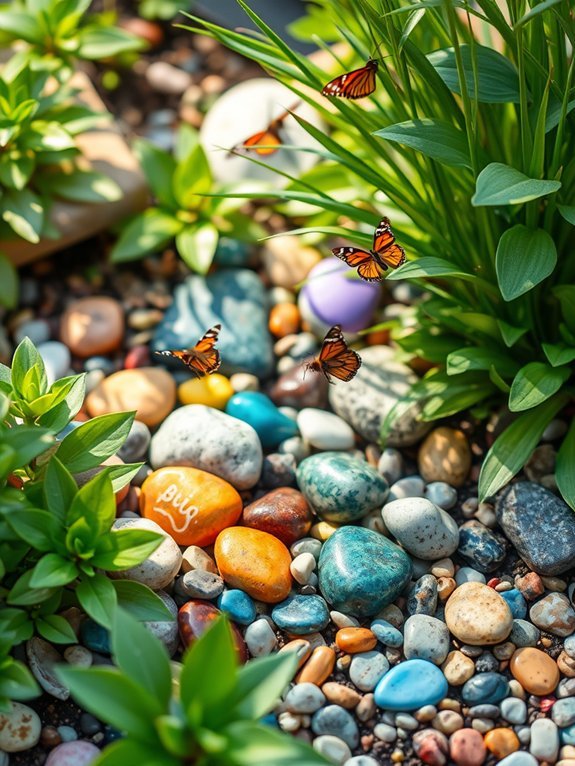
Decorative stones and pebbles can add both beauty and functionality to your wildlife garden. By strategically placing them throughout your space, you create natural habitats for insects and small critters. Use various sizes and colors to enhance visual interest while providing shelter and hiding spots.
When selecting stones, opt for those that blend with your garden’s aesthetics, like smooth river stones or rugged granite. You can create pathways or define garden beds, making your garden both practical and inviting. Don’t forget to leave gaps between the stones, allowing insects like beetles and ants to thrive.
With these additions, you’ll not only enhance the overall design but also support a diverse ecosystem right in your backyard.
Hang a Garden Mirror
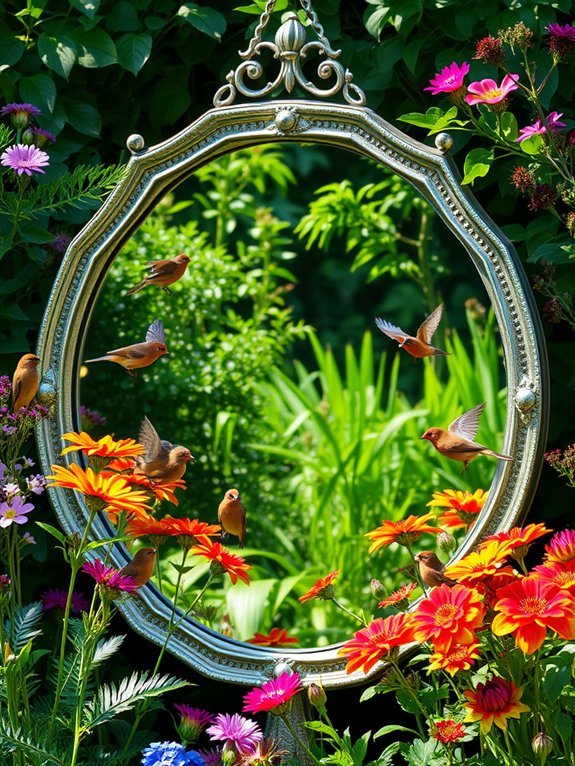
Adding a garden mirror can transform your wildlife garden into a visually striking space. Not only does it create an illusion of depth, but it also attracts birds and other creatures. Hang your mirror in a spot that catches sunlight, reflecting light into shadowy areas, drawing wildlife nearer. Position it near flowering plants, where pollinators are likely to visit. The mirror’s reflection also provides a safe haven for birds, making them feel secure as they explore your garden. Choose a weatherproof mirror to guarantee durability, and consider elegant frames that match your garden’s style. You’ll enjoy watching as the mirror enhances both your outdoor décor and the vibrancy of wildlife visiting your space.
Design a Wildflower Meadow

Incorporating a wildflower meadow into your wildlife garden can create a vibrant habitat while enhancing the overall aesthetic. A wildflower meadow attracts birds, butterflies, and beneficial insects, offering them food and shelter. To design your perfect meadow, consider these tips:
- Choose native wildflower seeds for better adaptation to your local environment.
- Select a sunny location that receives at least 6 hours of sunlight daily.
- Prepare the soil by removing weeds and loosening the top layer.
- Mix a variety of flowers to guarantee blooms throughout the growing season.
- Minimize maintenance by allowing natural growth; cut back only in late winter.
Creating a wildflower meadow not only supports wildlife but also brings beauty to your garden!
Build a Bug Hotel
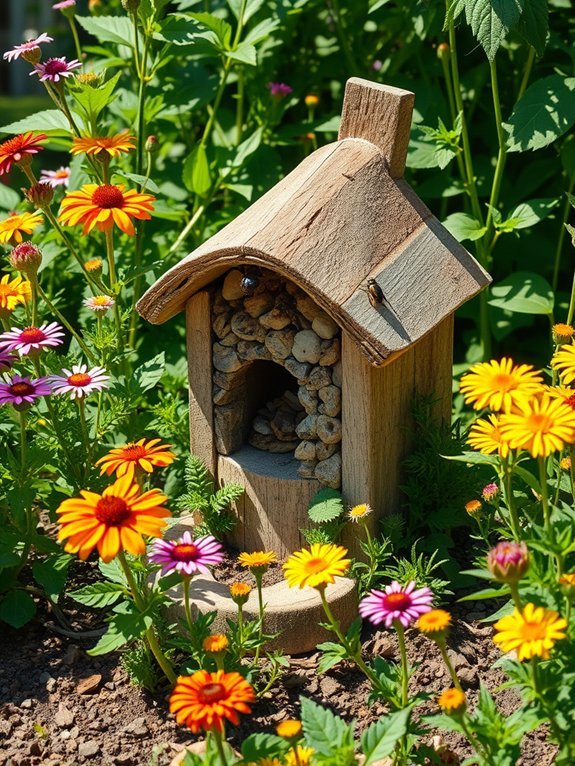
Building a bug hotel isn’t just a fun project; it also plays an essential role in supporting local biodiversity. Start by choosing a sheltered spot in your garden, ideally facing south. Gather materials like wooden pallets, bamboo sticks, pine cones, and straw. Stack these items in a wooden frame or a simple box, creating various sizes of compartments to attract different insects. Be creative—use logs with drilled holes or even old terracotta pots! Make sure your structure is sturdy and secure. Once assembled, leave it undisturbed to invite beneficial insects like bees, ladybugs, and lacewings. Not only does this provide shelter for them, but it also enhances your garden’s ecosystem, leading to healthier plants and increased pollination.
Step-by-Step Guide to Wildlife Decor
Use Scented Plants to Attract Pollinators

While you may think all plants are equally appealing to pollinators, using scented plants can greatly enhance your garden’s attractiveness to these essential creatures. Choosing fragrant blooms not only makes your garden more inviting but also encourages a variety of butterflies, bees, and other pollinators to visit. Here are some aromatic plants to contemplate:
- Lavender
- Sweet Alyssum
- Bee Balm
- Jasmine
- Mint
Place a Bird Bath
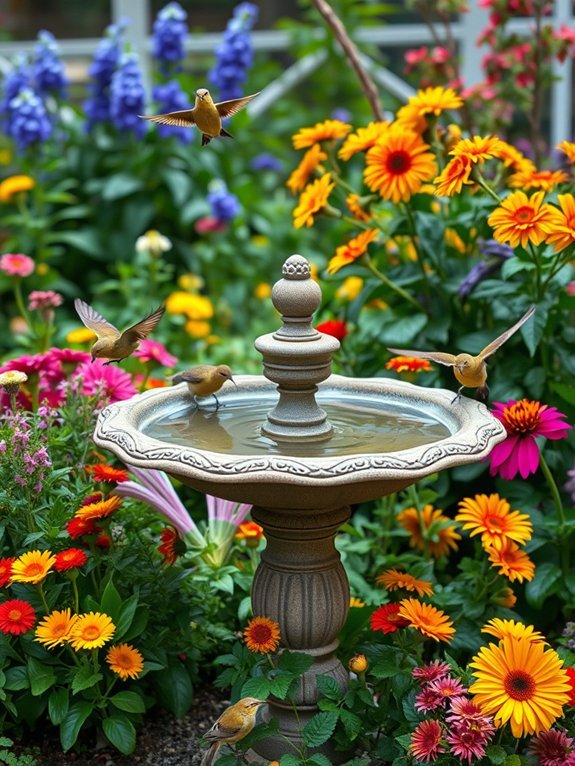
A bird bath can transform your garden into a lively haven for feathered friends. Not only does it provide a vital water source for birds, but it also attracts a variety of species. To maximize its effectiveness, consider the following factors:
| Aspect | Recommendation | Why It Matters |
|---|---|---|
| Depth | 2-3 inches shallow | Safer for smaller birds |
| Location | Sunny & visible spot | Attracts birds with ease |
| Material | Durable ceramic or concrete | Lasts through weather changes |
| Maintenance | Clean weekly | Prevents algae & illness |
Set Up a Garden Trellis
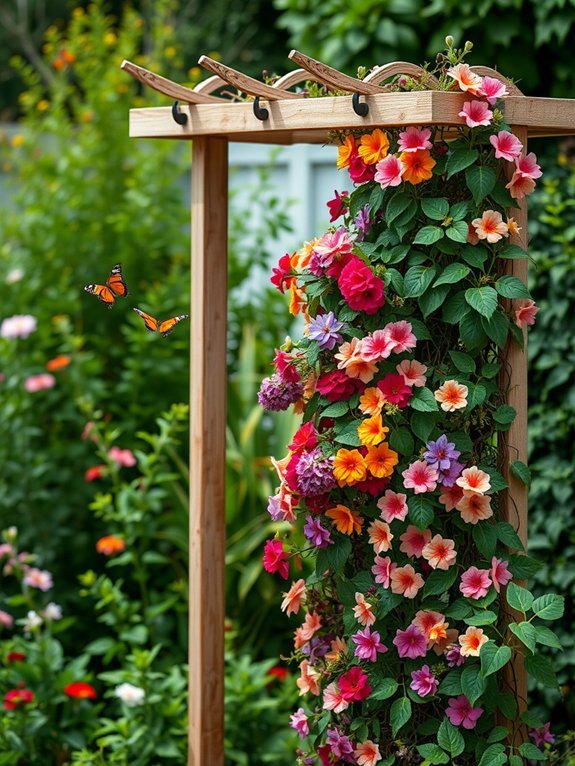
Adding a garden trellis can greatly enhance your outdoor space, providing both aesthetic appeal and functional benefits. A trellis not only supports climbing plants but also creates a vertical habitat that can attract various wildlife. Here are some tips to take into account when setting up your trellis:
- Choose native climbing plants, like beans or peas, to provide food for local wildlife.
- Position the trellis to allow sunlight while offering some shade.
- Incorporate fragrant flowers to entice pollinators such as bees and butterflies.
- Confirm it’s sturdy enough to withstand wind and weather conditions.
- Don’t forget to provide water nearby to support the wildlife drawn to your garden.
Your trellis can become a thriving environment for nature.
Create Natural Shelters

Creating natural shelters in your garden not only enhances its appeal but also provides essential habitats for birds, insects, and other small wildlife. To start, consider piling up leaves, twigs, or logs in a corner. This creates a perfect refuge for beneficial insects and small mammals. You can also leave some areas of your garden unmowed to encourage wild grasses and flowering plants, offering food and cover for butterflies and bees. Adding rock piles or stone walls can create microhabitats for reptiles and ground-nesting birds. If you’re feeling crafty, build a simple brush pile or install birdhouses using natural materials. These shelters enhance biodiversity, increase wildlife visibility, and contribute to a healthier garden ecosystem.
Hang Colorful Wind Chimes

While you’re enhancing your garden’s charm, hanging colorful wind chimes can add a delightful auditory element to your outdoor space. These cheerful decorations not only create pleasant sounds as the wind blows but also attract curious wildlife. Birds, in particular, are drawn to movement and sound, and your chimes might entice them to visit more frequently.
To make the most of your wind chime installation, consider these tips:
- Choose chimes with vibrant colors that stand out.
- Opt for various sizes and shapes to create visual interest.
- Hang them in areas where they can catch the breeze.
- Guarantee they’re made from durable materials for longevity.
- Position them near flowers or feeders to draw in more wildlife.
Enhance your garden’s ambiance while inviting charming creatures!
Incorporate Landscape Lighting
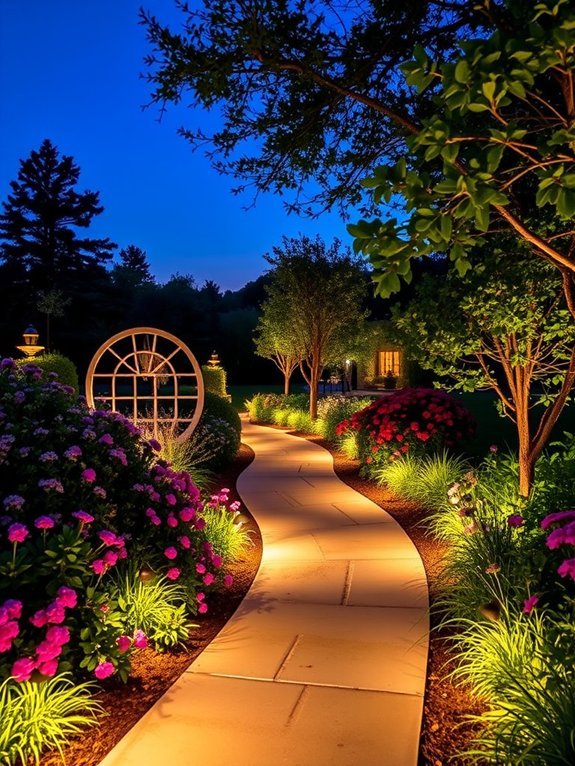
Wind chimes bring delightful sounds to your garden, but to truly highlight its beauty, incorporating landscape lighting takes your outdoor space to the next level. Strategic lighting can enhance the charm of your garden at night, creating an inviting atmosphere while showcasing key features like plants, pathways, and wildlife. Consider using solar-powered lights for eco-friendliness and ease; they charge during the day and illuminate your garden at night without extra energy costs. Install spotlights to direct attention to vibrant flowers or unique sculptures, and use soft pathway lights to guide visitors safely through your space. By illuminating your garden, you’ll attract nocturnal wildlife, enhancing both the beauty and biodiversity in your outdoor oasis.
Design a Zen Garden Space
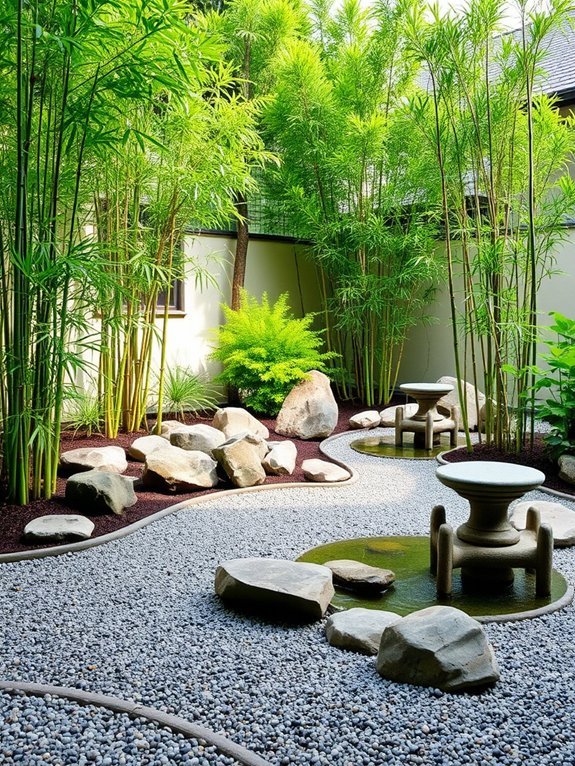
If you want to cultivate a sense of peace and tranquility in your garden, designing a Zen garden space is an excellent choice. These minimalist gardens invite mindfulness and attract tranquil wildlife. Here are a few elements you might include:
- Raked gravel or sand to symbolize rippling water
- Rocks or boulders representing mountains and natural formations
- Carefully selected plants like bamboo and drought-resistant succulents
- A small water feature, such as a fountain or pond
- Space for meditation and reflection, perhaps with a bench or stones
Use Repurposed Garden Art
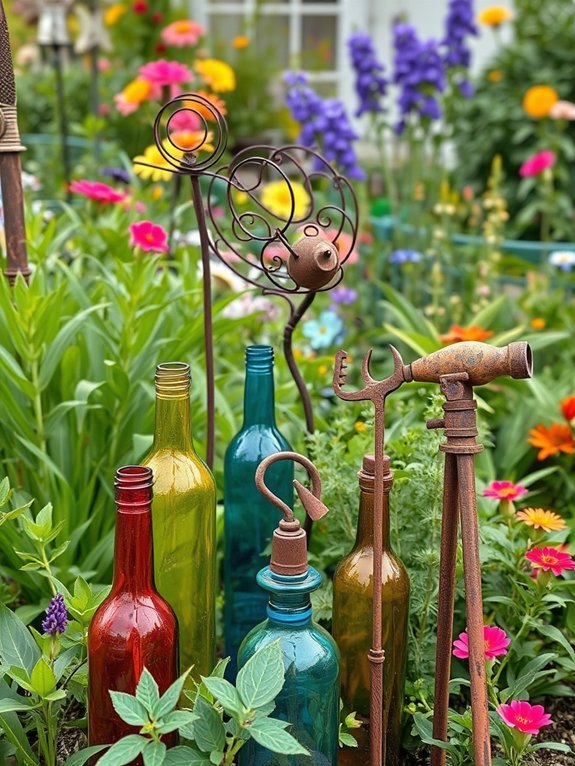
How can you transform your garden into a vibrant space while being eco-friendly? One effective way is by using repurposed garden art. Instead of purchasing new decor, consider giving a second life to old items. Old dishes can become charming plant holders, while vintage tools can serve as unique sculptures.
Upcycling not only reduces waste but also adds character to your garden. You might create a birdbath from an old sink or craft a signpost from wooden pallets. Ascertain that these materials are safe for wildlife, avoiding toxic paints or chemicals.
This approach not only attracts attention but also provides habitats or food sources for various species, making your garden a welcoming haven for wildlife.
